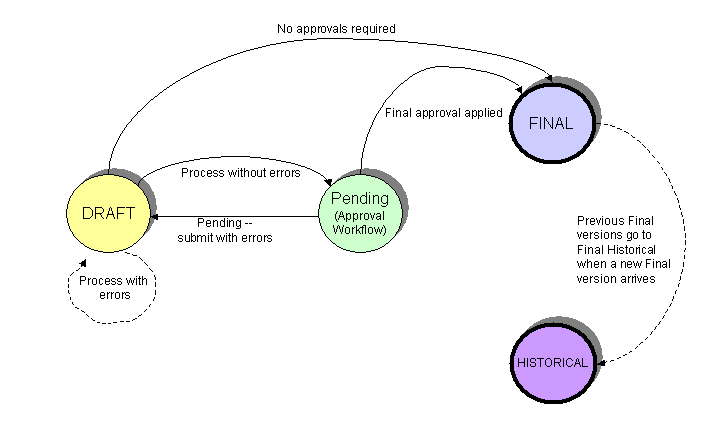
A document's life cycle normally consists of the following phases:
Draft – The document has been entered into the system, but it is not yet affecting system operations. All document versions start in this phase. Drafts can be freely edited and deleted since they make no application updates.
Pending – The document has been tentatively accepted subject to approval rules; funds are reserved to assure final acceptance. Pending application database fields are updated.
Final – The document has been fully accepted into the system. All approvals, when applicable, have been applied, the pending database updates have been reversed and replaced with permanent updates.
Historical (Final) – A Final version of a document that has been superseded by a later version of the same document.
However, the following additional phases are also supported for documents:
Conflict Draft – a draft version set aside to allow creation and processing of a new Draft version (normally by an off-line or background process)
Template – a partial or full version of a document set aside as a template to be used as a data entry shortcut
The diagram below depicts how documents transition from one phase to the next.

You enter the initial document into the system. It is saved in a Draft phase.
You submit the document for processing. At this time, the document is validated against the business rules defined for this document code. In the event that the document does not pass all of the business rules, the document remains in a Draft phase, and displays the appropriate error messages. This provides you with an opportunity to correct the information and re-submit the document.
Once all business rules are met, there are two potential routes that this document can take on a successful submit:
If no approvals are required, as determined by the Document Control (DCTRL) table (or the approval rules), the document transitions into the Final phase. At this time, this is an active document, able to be reported on and referenced by subsequent transactions.
If the document requires additional approvals, it transitions from Draft to a Pending phase and awaits the necessary approval actions. At this time, funds are tentatively encumbered.
Once all approvals are applied, the document once again invokes the business rules to ensure that no additional impediments to processing have occurred in between the time the document entered into the Pending phase and the time that the last approval was applied. If the document no longer passes the business rules, it returns to a Draft phase to await correction and re-submission. All pending updates are reversed. Otherwise, the document transitions into the Final phase, to be fully accepted into the system.
At this time, the original document has completed its life cycle. However, due to other circumstances in the system, it may be necessary from time to time to modify the original document to contain additional information. This Final version of the document may need to be superseded by a subsequent version. At that time, this version of the document transitions to Historical to make way for the latest version.